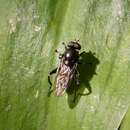Chalcosyrphus (Xylotomima) nemorum (Fabricius 1805), the Dusky-banded Leafwalker, is a common species of syrphid fly with a Palearctic and Nearctic distribution. Hoverflies get their names from the ability to remain nearly motionless while in flight. The adults are also known as flower flies for they are commonly found around and on flowers, from which they get both energy-giving nectar and protein-rich pollen. Larvae have been found under the bark of Larix, Pinus and a variety of hardwoods.[9]
Description
External images For terms see Morphology of Diptera
Wing length 6.5-8.25 mm. Hind femora are swollen and deep. Hind tibiae strongly curved and the ventral surface with closely-set short black hairs for the whole length. The abdomen is short tergites 2-4 with a pair of pink or orange-brown marks. The legs are black with yellow knees and yellow tarsi. [10] [11] [12][13] The larva is figured by Hartley (1961).[14]
Distribution
Fennoscandia South to the Pyrenees and from Ireland East through Northern, Central and Southern Europe (to South Italy) across the Palearctic into Russia and the Russian Far East and Sakhalin and Japan. In the Nearctic from Alaska to Nova Scotia and South to California. (see distribution map)[15][16][17]
Biology
The habitat is forest wetland (Alnus - Salix carr, deciduous forest and woodland with streams). Adults frequent sunlit foliage of bushes on trunks of fallen trees beside water and settle on damp mud at the water's edge. Flowers visited include white umbellifers, Caltha, Anemone nemorosa, Euphorbia amygdaloides, Ranunculus, Rubus idaeus, Potentilla erecta, Sorbus aucupariaand Taraxacum.[16] Flies from the beginning of May to the end of September.[18]
References
-
^ a b Fabricius, Johann Christian (1805). Systema antliatorum secundum ordines, genera, species. Bransvigae: Apud Carolum Reichard. pp. i–xiv, 1–373. Retrieved 5 June 2020.
-
^ a b Meigen, Johann Wilhelm (1822). Systematische Beschreibung der bekannten europäische n zweiflugeligen Insekten. Hamm: Dritter Theil. Schulz-Wundermann. pp. x, 416, pls. 22–32. Retrieved 14 April 2019.
-
^ Panzer, Georg Wolfgang Franz (1804). D. Jacobi Christiani Schaefferi Iconum Insectorum circa Ratisbonam indigenorum Enumeratio Systematica. Erlangae [=Erlangen].: Palmii. pp. xvi + 260. Retrieved 25 July 2021.
-
^ Shannon, Raymond Corbett (1926). "Review of the American xylotine syrphid-flies". Proceedings of the United States National Museum. 69 ((9)[2635]): 1–52. Retrieved 19 July 2021.
-
^ Violovitsh, N.A. (1980). "New species of flower flies (Diptera, Syrphidae) of the Palaearctic fauna". Nov. mal. vidy Faun. Sibir. (in Russian). 14: 124–131.
-
^ Walker, F. (1849). List of the specimens of dipterous insects in the collection of the British Museum. Part III. London: British Museum (Natural History). pp. 485–687.
-
^ Loew, H. (1864). "Diptera Americae septentrionalis indigena. Centuria quinta". Berliner Entomologische Zeitschrift. 8: 49–104. Retrieved 11 July 2021.
-
^ Violovitsh, N.A. (1975). "Some new species of hover-flies (Diptera, Syrphidae) from the fauna of the USSR". Nov. mal. vidy Faun. Sibir. (in Russian). 9: 73–89.
-
^ Stubbs, Alan E.; Falk, Steven J (1983). British Hoverflies: An Illustrated Identification Guide (2nd ed.). London: British Entomological and Natural History Society. pp. 253, xvpp. ISBN 1-899935-03-7.
-
^ Van Veen, M. (2004) Hoverflies of Northwest Europe: identification keys to the Syrphidae. 256pp. KNNV Publishing, Utrecht.
-
^ Van der Goot,V.S. (1981) De zweefvliegen van Noordwest - Europa en Europees Rusland, in het bijzonder van de Benelux. KNNV, Uitgave no.32: 275pp. Amsterdam.
-
^ Bei-Bienko, G.Y. & Steyskal, G.C. (1988) Keys to the Insects of the European Part of the USSR, Volume V: Diptera and Siphonaptera, Part I. Amerind Publishing Co., New Delhi. ISBN 81-205-0080-6.
-
^ Coe, R.L. (1953) Diptera: Syrphidae. Handbks.ident.Br.insects, 10(1): 1-98. R.ent.Soc.London. pdf Archived 2018-10-04 at the Wayback Machine
-
^ Hartley, J.C. (1961) A taxonomic account of the larvae of some British Syrphidae. Proc.zool.Soc.Lond.,136: 505-573.
-
^ Fauna Europaea
-
^ a b Peck, L.V. (1988) Syrphidae. In: Soos, A. & Papp, L. (eds.) Catalogue of Palaearctic Diptera, 8: 11-230. Akad.Kiado, Budapest.
-
^ Vockeroth, J. R. (1992). The Flower Flies of the Subfamily Syrphinae of Canada, Alaska, and Greenland (Diptera: Syrphidae). Part 18. The Insects and Arachnids of Canada (PDF). Ottawa, Ontario: Canadian Government Pub Centre. pp. 1–456. ISBN 0-660-13830-1. Archived from the original (PDF) on 2013-06-15. Retrieved 2017-01-15.
-
^ Speight, M.C.D. (2011). "Species accounts of European Syrphidae (Diptera)" (PDF). Syrph the Net, the Database of European Syrphidae. 65: 285pp.


